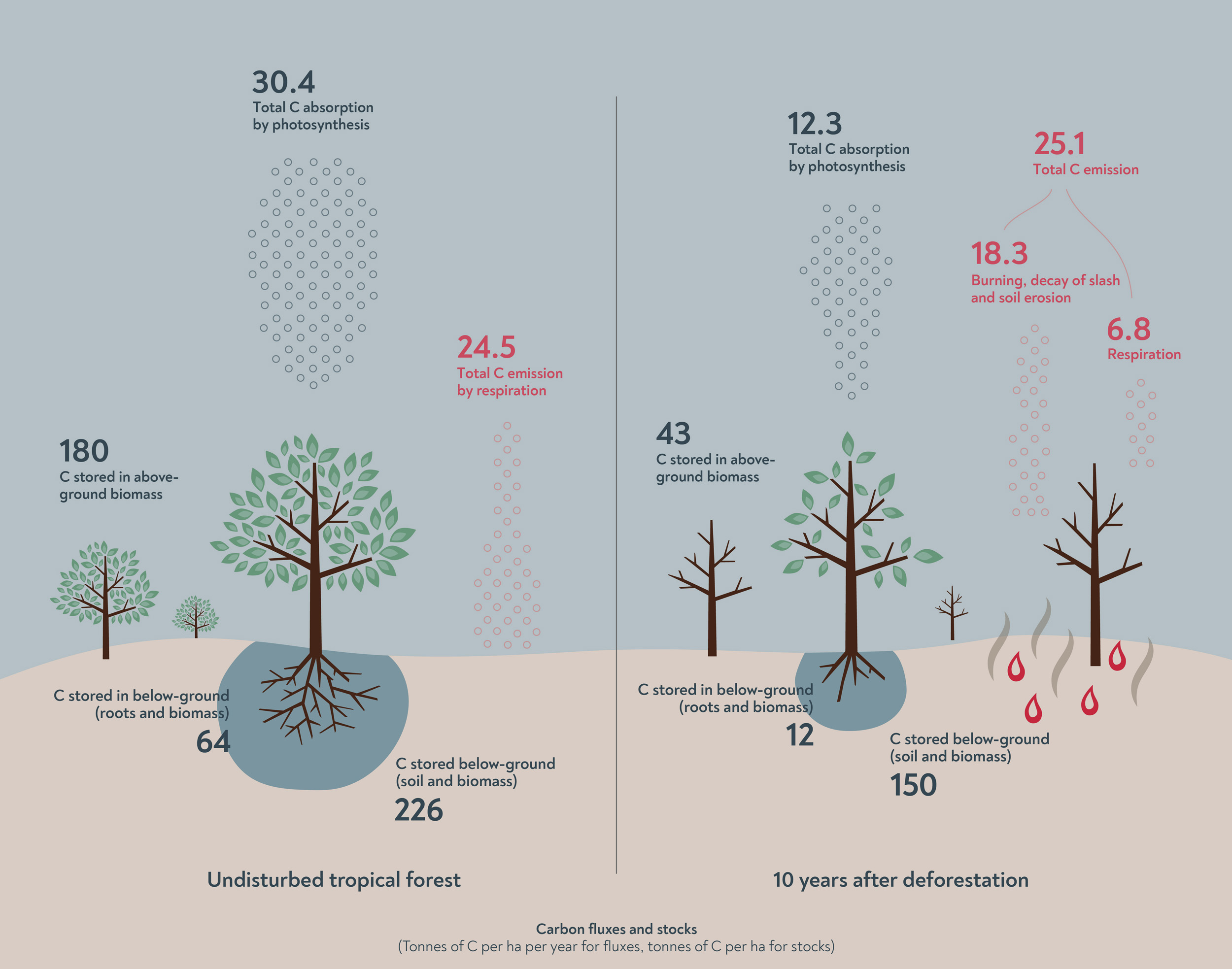Land Use Changes
Establishing the coffee plantations in Brazil that made it the world’s biggest supplier of coffee came at a huge environmental cost. Huge swaths of tropical rainforest were felled and burned to clear the land for coffee seedlings (M Pendergrast, 2010). The fertile soil, enriched with humus from centuries of forest growth and added minerals from the ash, was ideal for growing coffee. In full sun, the coffee plants would grow rapidly and suck up the nutrients from the soil. Meanwhile, without the forest cover, the soil would be rapidly eroded and its nutrients washed away. When the farmland became ‘tired’ and the coffee trees were no longer productive, new areas of forest would be cleared to replace it.
This pattern of land use changes has been repeated nearly everywhere that coffee is grown. Coffee production increases by 144,400 tonnes per year, and in nearly all countries where coffee production is increasing, the primary source of new coffee-growing lands is deforestation (P Baker, 2014). In Brazil, however, the increase in production is mainly due to improved technology allowing greater yields per hectare.
Clearing rainforest to grow coffee has a triple effect on carbon emissions. Firstly, the trees’ ability to absorb carbon from the atmosphere is lost. Tropical rainforests across Africa and South America can absorb nearly one-fifth of the world’s carbon emissions (SL Lewis et al., 2009), but deforestation and the resulting droughts and increased temperatures mean that this ability is being lost (W Hubau et al., 2020).
Secondly, the trees themselves are a huge sink of carbon, which is released to the atmosphere when it is burned or left to decompose. The Amazon forest stores 127 billion tonnes of carbon, equivalent to 140 years worth of anthropogenic carbon emissions (Rainforest Trust, 2017).
Finally, the carbon from organic matter in the soil is also rapidly released (AL Varcho, 2015). Because of these combined effects, deforestation on its own is responsible for 10% of global carbon emissions (Rainforest Alliance, 2018).
 Half of all the carbon stored in the world’s forests is found in tropical areas. Deforestation accounts for 10% of the world’s total human-induced CO2 emissions. Image by GRID-Arendal.
Half of all the carbon stored in the world’s forests is found in tropical areas. Deforestation accounts for 10% of the world’s total human-induced CO2 emissions. Image by GRID-Arendal.
Reducing the impact of land use changes is thus vital to make coffee more sustainable. Moving to less-intensive coffee production systems — for example, by converting farms to organic cultivation — can be counterproductive in reducing emissions if it results in more land being brought under cultivation to compensate for lower yields (MRA Noponen et al., 2012).
In a standard carbon-footprint analysis, only land use changes in the previous 20 years are included in the assessment (B Killian et al., 2013). However, carbon storage derived from shade trees and perennial crops are also excluded. Coffee farming has been shown to provide long-term carbon stores, in the coffee trees themselves and in shade trees, but this carbon sink is excluded from most carbon footprint analyses (MRA Noponen et al., 2012). If the shade trees are deliberately planted as part of a change from a monoculture, the land use changes associated with converting to coffee farming can even manifest a positive effect on carbon sequestration.
منظومة اتخاذ القرار - (قيد الترجمة)
دورة إلكترونية مجانية تلقي نظرة ناقدة على تأثير المناخ في صناعة القهوة
بدأنا في باريستا هاسل في إعداد دورة تدريبية مجانية تحت اسم منظومة اتخاذ القرار - (قيد الترجمة) لمساعدة معدي القهوة وأصحاب المقاهي في اتخاذ قرارات مستنيرة حول كيفية العمل في عالم تعصف به التغيرات المناخية. نعترف بأن صناعتنا قد شابها تاريخ من الاستعمار والاستغلال ونشر الادعاءات الزائفة بحماية البيئة. وتهدف هذه الدورة إلى تمكين القراء من تولي زمام الأمور بأنفسهم، وقد كان الفضل لأشخاص رائعين مثل البروفيسور ستيفن أبوت (الذي صنع تطبيقًا لهذه الدورة يتيح لجميع طلابها الوصول إلى التكنولوجيا التي يحتاجونها للقيام بتحليل دورة الحياة الخاص بهم)، نأمل بأن ننجح بتشجيعكم من خلال هذه الدورة على العمل على تقليل الانبعاثات خلال عملكم. وبدايةً من الدرس الأول، ستكتشفون كيف يمكن لمعدي القهوة التأثير بشكل كبير في الحد من الانبعاثات الكربونية. ننشر هذه الدورة التدريبية على مراحل هنا على مدونتنا لتكون متاحة لمشتركي باقة باريستا هاسل غير المحدودة: مع تحديثاتهم غير المحدودة.




0 تعليق